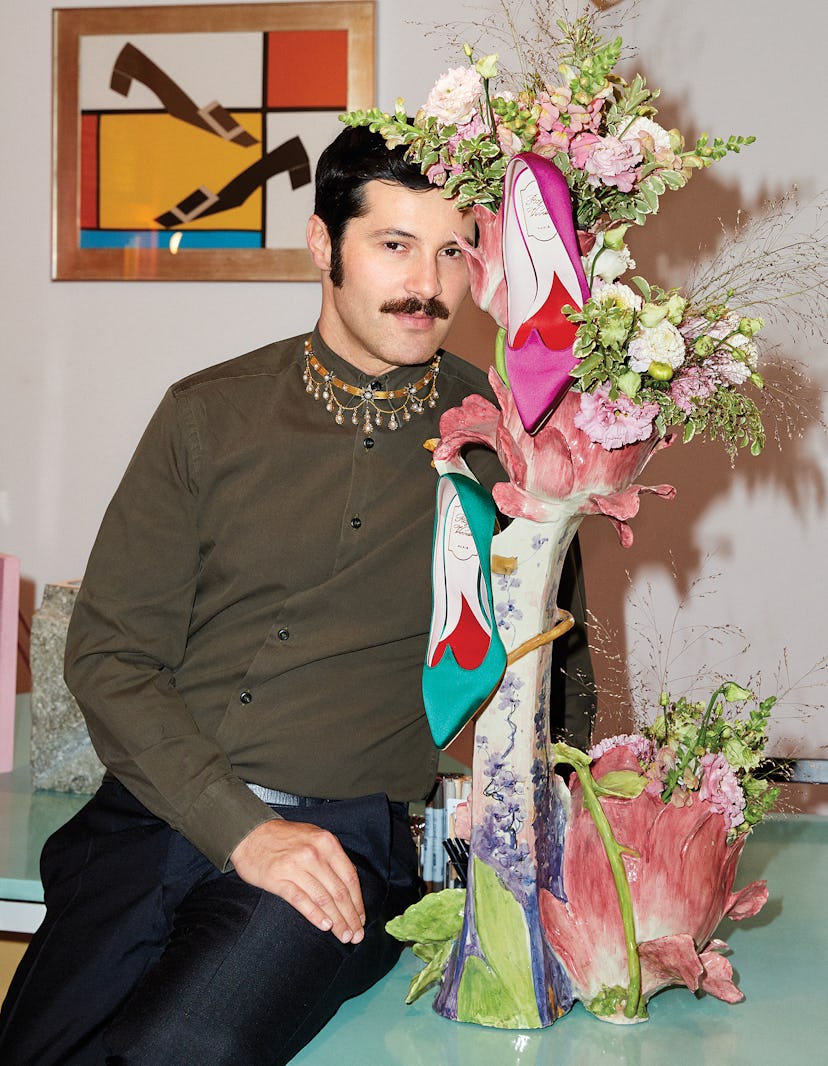How Gherardo Felloni Is Modernizing the House of Roger Vivier
Roger Vivier, the storied footwear house, strides into a new era with a Renaissance man at its helm. Karin Nelson goes toe to toe with the creative director Gherardo Felloni.

Gherardo Felloni could have successfully tackled any number of fabulous careers. He can decorate a room like nobody’s business, boldly pairing midcentury French and Italian furniture with Chinese Art Deco carpets and contemporary works from the likes of the artist Nicolas Party and the furniture designer Duccio Maria Gambi. “I love the idea of a house not full of old pieces,” he says of his own 19th-century home in Paris, which has appeared on the cover of several European design magazines. He has also decorated a few friends’ homes in his native Italy, though he is reluctant to be called an interior designer. He is not an opera singer either, despite the fact that he is a tenor and studied for six years at a music conservatory in Paris, and has performed at several “little concerts,” as he describes them. Although he has an important collection of vintage parures and necklaces, which he wears on a regular basis, he is not a jeweler. Nor is he an architect, which was his first passion as a young man. Rather, at the behest of his father, who owned a luxury shoe factory in Tuscany that produced footwear for Hermès and Gucci, Felloni, 38, channeled his immense creative talents into shoe design. “My father was right,” he concedes. “Because when I started making shoes, I never wanted to stop.”
He went on to head up the footwear atelier at Dior, where he worked with both John Galliano and Raf Simons, before overseeing accessories at Miu Miu. One of his favorite designs there, a wildly popular furry slide covered in pearls, hangs on his bedroom wall. This past spring, he landed his dream job—he was named creative director at Roger Vivier, taking over from Bruno Frisoni, who stepped down after 16 years. “Roger Vivier was always one of my biggest inspirations,” Felloni says of the man credited with introducing, in the 1950s, new shapes like stiletto heels and pointy lasts that forever changed the footwear industry. Zhooshed up with couturelike embellishments, Vivier’s sophisticated designs immediately found favor with Elizabeth Taylor and the Duchess of Windsor, among many others. “He was an architect, probably—or just a genius,” says Felloni, whose fascination led him to collect rare Vivier designs, including an original Belle Vivier style, the house’s signature block-heel shoes with a big buckle, made famous in 1967 when Catherine Deneuve wore them in Belle de Jour, directed by Luis Buñuel.
Shoes from the latest collection.
Not surprisingly, Felloni’s first order of business upon arriving at the house—aside from painting the showroom “couture pink” and adorning it with statement pieces from home, such as a life-size statue of Adonis—was diving deep into its expansive archives. He emerged with more than a few ideas of how to modernize the brand while retaining signature silhouettes and the use of rich colors. “That was my challenge—to evolve the maison, much like Roger Vivier did,” he says. “Oh, my God, big shoes to fill!”
His debut collection is every bit as elegant and whimsical as one would expect, and includes such novelties (at least for Vivier) as running shoes. “I approached them in a mathematical way,” Felloni says of the conspicuous kicks, which are crafted in flyknit, and contain a two-and-three-quarter-inch shock heel and flexible rubber buckle. “It is what every woman today needs and wants.” There is also a reinterpretation of the Virgule, or comma, heel that was first introduced in 1963—his is chunkier, covered in crystals, and affixed to a satin bootie and feather-festooned sling back. The I Love Vivier pump, a sexy style with a swooping décolleté that recalls one from the ’60s, has been reworked with a two-tone insole that forms a trompe l’oeil effect. “You see a heart, from the point of view of the wearer.”
As for the house’s adored Belle Vivier style? Not wanting to mess with greatness, Felloni left it as is—but introduced a younger, more retro sister version called Très Vivier, which is closer to what the original looked like in the ’60s, with its cube heel and squared-off buckle. It comes in an array of materials—velvet, satin, jacquard—with a very bourgeois bag to match. “It feels contemporary, but also from another epoch,” Felloni says. “Which is exactly how I like things.”